Physical Tour
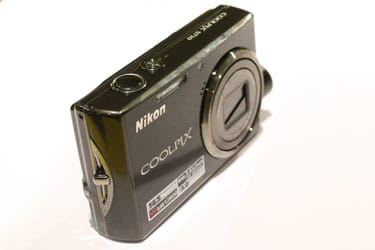
Front
The front of the S710 is dominated by the lens, which telescopes out of the camera body in two sections. The other interesting points here include the microphone (located to the left of the lens, under the three small holes), the self-timer lamp, the IR illuminator and the small, thin flash.
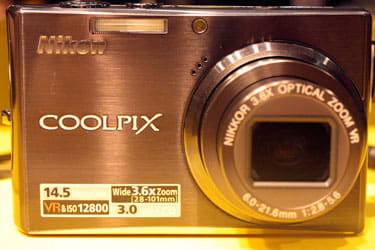
The front of the S710 is dominated by the lens.
Back
The major feature of the back of the S710 is the 3-inch LCD screen, which has about 230,000 pixels. To the right of the screen are the controls; from the top down we have the zoom control, the flash indicator, the mode and playback buttons, the rotary multi-select and the memory and delete buttons. The rotary multi-select combines a scroll wheel with a 4-way controller, offering two types of control in one convenient place.
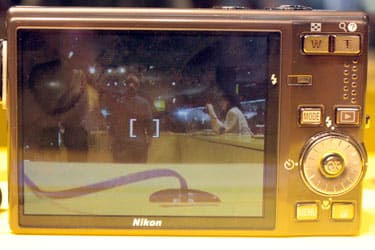
The major feature on the back of the camera
is the 3-inch LCD screen
Sides*
*The left side of the camera does not have any significant features. The round disk is a security tag that was fitted onto the model we looked at at the Photokina show; it is not a standard feature.

The left side of the camera has no
major features**

*The right side offers one important
connector, to the wrist strap.
*
The top of the S710 has a few significant features; the on/off button (with a small LED light to the left of it) and the shutter button. The zoom control is on the rear of the camera.

*The top of the S710 is where the on/off button and the
shutter button call home. *
The bottom of the S710 is where the cover for the battery and media card port is located, as well as the tripod socket and the cover over the small USB port.
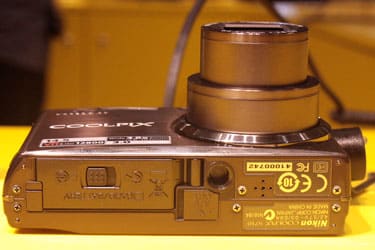
*The bottom is the home to the battery and memory card cavity
plus the USB and A/V port
*
Components
Viewfinder
There is no viewfinder on the S710; all of the image previews and photo composition are handled on the monitor.
LCD Screen
For the size of the camera, the 3-inch screen is pretty big, and it takes up most of the back of the camera. The screen looked reasonably clear and bright in our informal tests at the Photokina show, and we found the on-screen image preview to be pretty good; we didn't notice a lot of jerky or jittery video as we panned around. The screen is not particularly sharp, though; it has just 230,000 pixels and many cameras have higher resolutions, such as the Samsung TL34HD, which has 460,000 pixels. However, the Nikon S710 screen is adequate for general use, as you can see fine details on photos to make sure that they are in focus.

*The 3-inch LCD screen dominates the back of the S710,
but it is not overly sharp*****
Flash
The flash is very small and thin, and located quite close to the lens, which might exacerbate the red-eye in photos. We weren't able to test this at the Photokina show, though. Nikon claims a flash range of 1 foot, 8 inches to 27 feet at the wide-angle setting. This sounds somewhat optimistic, but we will have to wait until our full review is complete before we can discuss this in more detail.
**

The long, thin flash is located close to the lens.
******Lens**
The lens is a 3.6x zoom model made by Nikon themselves. It has a focal length of 6 - 21.6 mm, which works out the equivalent of a 28 -101mm lens on a 35mm camera. That's a decent range for a compact camera, and we like the way it starts at the relatively wide setting of 28mm. Most compacts offer longer zooms at the cost of a smaller angle of view, but a bigger zoom won't help when you can't get your family into a group shot because the wide angle is not wide enough.
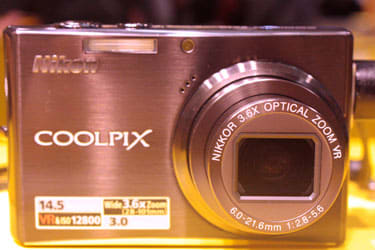
The lens is a homegrown 3.6x zoom model
Connections
The S710 only has a single connection to the outside world; a port under a plastic cover on the base of the camera accepts both the USB and A/V connection. Cables for both are supplied with the camera, but make sure you don't lose proprietary wires, since they'll be hard-to-find and expensive to replace. There is no power connection for using an external AC adapter or charging the battery.

This single port does double duty as the USB and A/V out port.
Battery
The S710 is powered by a small 1080mAh battery that fits into the battery cavity on the base of the device. Nikon claims a battery life of 250 shots for this battery, but we were unable to test this at the Photokina show. One thing to note is that the battery cannot be charged inside the camera itself; it has to be removed and then charged in the included battery charger.
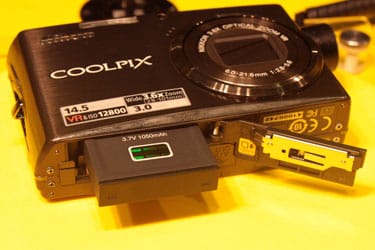
The battery slides into the battery cavity,
alongside the media card. Memory
The S710 has around 42MB of internal memory, but the primary image storage is an SD card, which slides neatly into the slot just underneath the battery.
******Other Features**
*Image Stabilization *– The S710 includes optical image stabilization, where an element of the lens moves to compensate for camera shake. Nikon refers to this feature as VR (or Vibration Reduction), but the principle is the same as that used by other manufacturers. We were unable to test the efficacy of this feature at the Photokina show.
Design / Layout
Model Design / Appearance
Nikon refers to the S710 as the 'World’s most compact design,' but there are a couple of asterisks on that. First is that this claim is only amongst 14-megapixel cameras with optical image stabilization, which narrows the field down significantly. And secondly, it is no longer true; the Samsung TL34HD has both 14-megapixel resolution and optical image stabilization. Nikon gets around this by adding this note: 'Among 14-megapixel compact cameras equipped with optical vibration reduction as of August 7, 2008,' but they really ought to update their web site now we are in October and the claim is no longer true. Which is not to say that the S710 has anything to be ashamed of in its figure: at one inch thick, it's a pretty small camera that would fit neatly into a shirt pocket or smallish handbag.
Size and Handling
The S710 fits fairly comfortably into the hand; the index finger falls right onto the shutter and the thumb falls onto the area below the zoom control. However, we did find that it was somewhat prone to slipping when we moved the thumb to zoom in or out. The zoom control really needed two hands to use comfortably without the camera slipping.

*
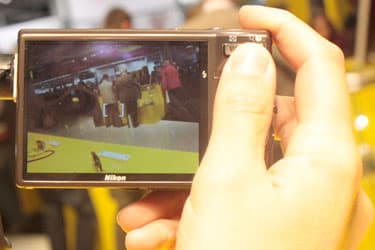
-
We found that the Nikon S710 was somewhat prone
to slipping when using the zoom control
Menu
The S710 has slightly unusual menu structure, with various options appearing on a circular dial when you hit the mode button. You can scroll around this list with the scroll wheel, and select the required option with the select key in the middle of the dial. It's a slightly confused approach, but it seems pretty easy to figure out once you grasp how it works.
*

**

When you hit the menu button (or select the setup option from the mode menu), you get a more conventional list-style menu that can be scrolled down using the multi selector either as a scroll wheel or a directional control. Some of these menus are rather long, but the screen includes a small guide in the top right corner that shows which screen you are on. The setup menu is about 4 screens long, so finding an option on this menu can be a somewhat tedious exercise. *
**

*
**Ease of Use
Overall, the S710 is a moderately easy to use camera, with most of the features easily accessible. Changing the scene mode isn't that easy, as you have to hit the mode button, scroll around the menu to the the screen option, click on the select button, then select the new scene mode. That all takes a fair amount of time; it would have been preferable to have some way of jumping straight to the scene mode menu. However, you do have the option of simply putting the camera into scene auto selector mode, where the camera automatically picks the scene mode to use, based on the preview image.
Modes
Auto Mode**
The S710 has a full Auto mode; set the mode dial to auto mode and the camera makes all of the decisions. We weren't able to do much testing on this at the Photokina show, but it seemed to make the appropriate decisions for taking photos of eager Nikon enthusiasts at the company's show booth. If you prefer a bit more control, Program mode sets the camera to make most of the decisions, but allows you to control setting such as the ISO, flash, etc. You can also vary the aperture by rotating the scroll wheel.
Movie Mode
The S710 records video at up to 640 x 480 resolution, at up to 30 frames per second. This standard definition video mode puts the S710 a little behind the cutting edge; many cameras are now starting to shoot video at high definition resolutions. The maximum length of movies is set by the maximum file size the camera can handle; 2GB. That makes for a maximum movie length at the maximum resolution and frame rate of around 16 minutes. We were not able to do any testing of the image performance of the camera in movie mode.
Drive / Burst Mode**
Nikon claims that the S710 has a frame rate of about 1.4 frames per second at the maximum resolution, and our limited testing at the show would indicate that this is probably about right. A maximum of 5 shots can be taken at this speed; after this, the speed slows down significantly as the internal buffer memory gets filled up. A higher speed can be achieved with the high-speed continuous mode, which takes around 12 frames per second, but at a reduced 2048 x 1536 resolution. The S710 also has a mode called BSS (Best Shot Selector), where the camera takes 10 images and automatically selects the sharpest. The Multi-shot 16 mode takes 16 images at a rate of 0.8 frames per second, and then creates a mosaic of the images in one photo.
Playback Mode
The S710 has a decent selection of playback controls, allowing for the viewing of up to 12 thumbnails at once, as well as creating slide shows and selecting images for printing. Only a handful of image editing tools are available; the D-lighting feature (which attempts to restore shadow detail in images), image rotation and the creation of a smaller version of the image.
Custom Image Presets**
A wide selection of scene modes is available; 16 in all, including a panorama assist mode and a museum mode. There's also an auto mode that picks the scene mode from a more limited selection of seven scene modes, and a smile mode that takes a photo, then checks it to see if the subject is smiling. If no toothy grin is evident, the camera quickly takes another shot in the hope that the subject's mood has improved in the interim.
Control Options
Manual Control Options
Like most higher-end point-and-shoot cameras, the S710 has a good selection of manual controls, including shutter and aperture-priority modes, plus a full manual mode. In the full manual mode, the user sets the shutter speed, then the aperture, and then the ISO setting.
Focus
Auto Focus
We found the auto focus on the S710 to be pretty quick and responsive in our limited testing; the camera generally found the focus spot in less than a second or so. Unusually for a point and shoot, the S710 offers 9 focus points, and the user can choose which to use, or leave the camera to decide.
ISO
The ISO range of the S710 starts at ISO 100 and goes up to a very impressive 12800. However, settings above 3200 comes at the cost of lowered resolution; the highest ISO setting is limited to a 3-megapixel resolution of 2048 x 1536.
White Balance
Five white balance presets are available; daylight, incandescent, fluorescent, cloudy and flash. A full auto mode is also available, as well as a preset manual mode, where the camera measures a reference object and uses the appropriate white balance setting.
Metering
Only two metering modes are available; matrix and center-weighted. There is no spot metering mode, an unfortunate omission.
Shutter Speed
The shutter speed ranges from 1/2000 to 8 seconds in normal mode, although this can be increased to 1/4000 by using the high-speed continuous mode. That comes at the cost of decreased resolution, though.
Aperture
At the wide end of the zoom range, the widest aperture that the lens can manage is an impressive f/2.8, but this decreases to f/4.0 at the telephoto end of the range.
**Image Stabilization
**The S710 uses optical image stabilization, which generally does a better job of reducing camera shake than the electronic image stabilization that other cameras use. However, more manufacturers are now offering optical image stabilization across their product range, so the S710 is not that unusual.
Picture Quality / Size Options
The S710 offers a lot of options for image quality and size; 9 in all. They range from 4532 x 3264 at high quality right down to 640 x 480. Several options for photos at 16:9 aspect ratios are also available.
Picture Effects Mode
The S710 eschews the picture frame or cartoon speech bubble effects that we sometimes see, but it does offer a small selection of color mode effects, including standard color, vivid color, black and white, sepia and cyanotype for those early photography fans.
Conclusion
**
Conclusion**

The S710 ups the ante in terms of resolution, pushing point-and-shoot camera up to an incredible 14.5 megapixels. There is perhaps an argument that few really need this resolution level (especially on a compact camera), but it is nice to have the option to zoom in on a photo during the editing process and still have plenty of resolution to play with. Other than the resolution, though, there is not a lot of new stuff in this camera; it shoots standard definition video, has the same optical image stabilization system as previous camera generations and doesn't offer much else. The 12800 maximum ISO may be useful, but that comes at a big price in terms of resolution, pushing the maximum down to 3 megapixels.
And, despite what Nikon claims, it is not the smallest camera with this resolution; the Samsung TL34HD has the same resolution and zoom range, but is somewhat thinner. The Samsung also shoots high-definition video, so it looks like the S710 has some stiff competition. We'll be taking a closer look at both cameras soon.
Specs
**Specs Table
**{{manufacturer_specs_table}}{{raw_scores_table}}
Meet the tester
Richard Baguley is a veteran writer who has written about technology ranging from Alphabet to Zip file utilities. He has contributed to pretty much every major tech publication, including Amiga Format Magazine, PC World, Wired, CNET, Toms Guide, Forbes, and many others. He lives in the Boston metro area with his wife, dog, and an indeterminate number of cats.
Checking our work.
Our team is here to help you buy the best stuff and love what you own. Our writers, editors, and experts obsess over the products we cover to make sure you're confident and satisfied. Have a different opinion about something we recommend? Email us and we'll compare notes.
Shoot us an email